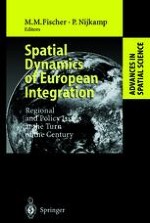1999 | OriginalPaper | Buchkapitel
Costs of European Monetary Union: Evidence of Monetary and Fiscal Policy Effectiveness
verfasst von : Helene Schuberth, Gert D. Wehinger
Erschienen in: Spatial Dynamics of European Integration
Verlag: Springer Berlin Heidelberg
Enthalten in: Professional Book Archive
Aktivieren Sie unsere intelligente Suche, um passende Fachinhalte oder Patente zu finden.
Wählen Sie Textabschnitte aus um mit Künstlicher Intelligenz passenden Patente zu finden. powered by
Markieren Sie Textabschnitte, um KI-gestützt weitere passende Inhalte zu finden. powered by
In general, there are two different ways of looking at the costs of a monetary union. Firstly, given the low inter-regional labour mobility in the European Union, whether the benefits of a common currency outweigh costs depends strongly on the degree of asymmetry of real shocks (Mundell 1961). If shocks are affecting countries that fail to meet the flexibility requirements, it would be better for those countries to have the possibility of resorting to the exchange rate instrument to adjust. A common currency may be preferable, however, if the countries are mainly affected by asymmetric money and financial market shocks. In Stage III of the European monetary union, speculative attacks, time-varying risk premia and currency substitution which could cause macroeconomic imbalances will disappear. Many empirical studies deal with the issue of whether the EU-15 are an optimum currency area. Some of these also include considerations about the likelihood of the emergence of new asymmetries in the future monetary union or the decreasing importance of asymmetries compared to the EMS.1
